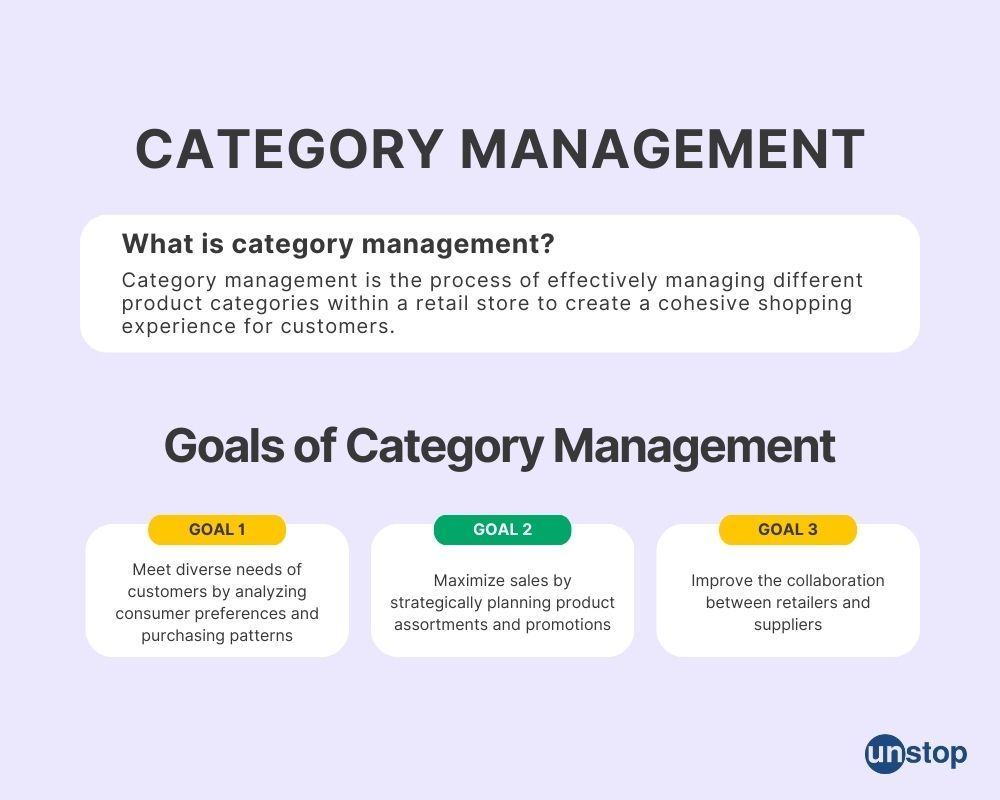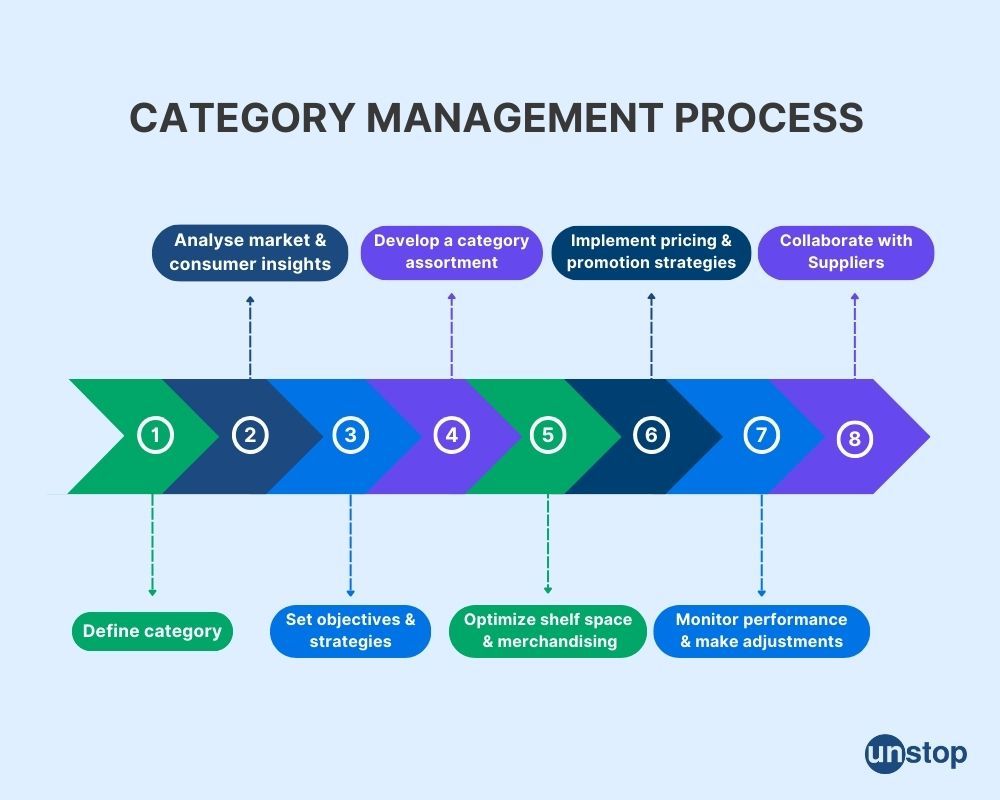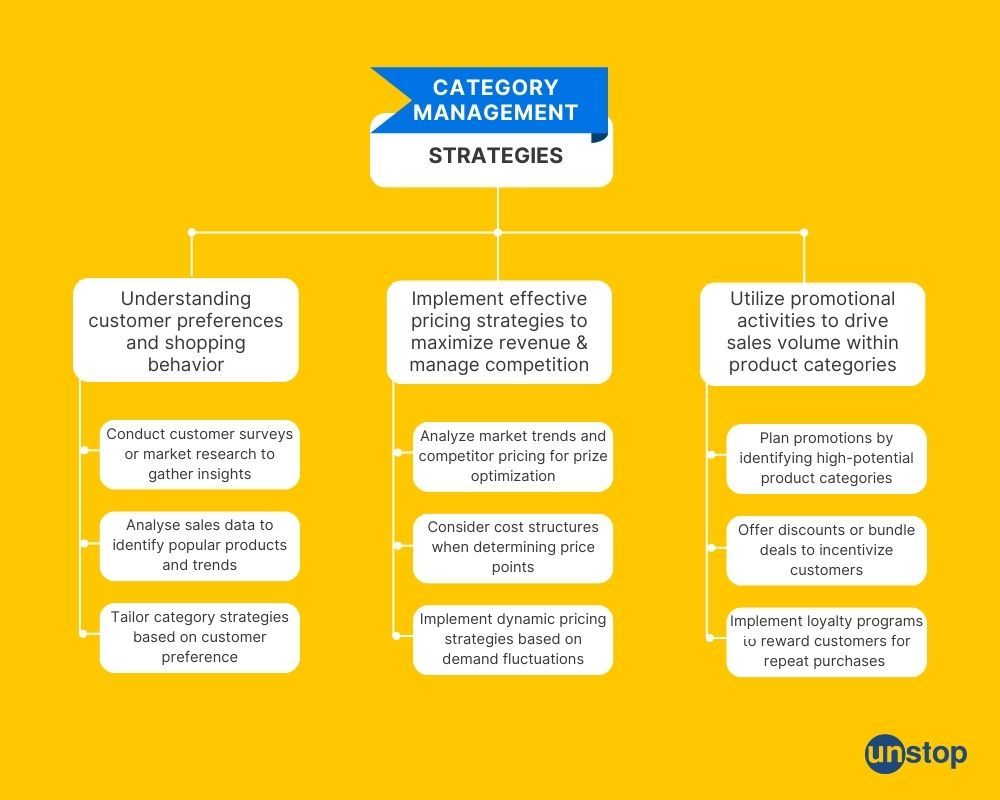- What is Category Management?
- Benefits of Category Management
- Understanding the Category Management Process
- Strategies for Successful Category Management
- Tools for Effective Category Management
- Frequently Asked Questions (FAQs)
Category Management 101: Process, Benefits, and Strategies

Category management is a strategic approach in business that focuses on understanding and effectively managing product categories. By analyzing and optimizing these categories, businesses can drive profitability and growth.
With the rise of complex supply chains and evolving consumer demands, category management plays a crucial role in ensuring the success of retail and procurement industries.
The category manager, also known as the category executive or category captain, takes charge of the category management function. Their responsibilities include category planning, promotion strategies, and maximizing product information to meet customer needs.
Effective category managers have a deep understanding of their respective industries and possess strong analytical skills to identify trends and opportunities within their product categories.
Let’s delve further into understanding category management, its strategies, and benefits:
What is Category Management?

Definition: Category management is all about effectively managing different product categories within a retail store. It involves grouping similar products together to create a cohesive shopping experience for customers. By understanding the unique characteristics of each product category, retailers can make informed decisions regarding pricing, assortment, promotions, and placement.
Here are the three tenets of category management:
Meeting Customer Needs
The primary goal of category management is to meet the diverse needs of customers. By carefully analyzing consumer preferences and purchasing patterns, retailers can tailor their product offerings to align with customer demands. This ensures that shoppers find what they need easily and are more likely to make a purchase.
For example, if a retailer notices an increase in demand for organic food products among its customers, it can allocate more shelf space to this category. This not only enhances the shopping experience but also increases the likelihood of sales.
Maximizing Sales
Category management also aims at maximizing sales by strategically planning product assortments and promotions. By analyzing sales data, retailers can identify top-selling items within each category and ensure their availability on shelves. They can also identify slow-moving products that may require adjustments in pricing or promotional strategies.
Effective category management involves optimizing the placement of products within the store layout. Retailers often place high-margin or impulse-buy items near checkout counters to encourage additional purchases.
Importance of Collaboration
Successful category management requires collaboration between retailers and suppliers. Retailers need accurate information from suppliers regarding new product releases, promotions, and market trends to make informed decisions about their assortments.
On the other hand, suppliers rely on feedback from retailers about consumer preferences and market demand to improve their own offerings. When both parties work together, they can create mutually beneficial strategies that drive sales and enhance the overall shopping experience.
Benefits of Category Management
Category management plays a crucial role in the success of retail businesses. Here’s why:
Improved Customer Satisfaction
One of the key benefits of effective category management is its ability to enhance customer satisfaction. By analyzing data and understanding consumer preferences, retailers can offer the right products at the right time. This ensures that customers find what they need easily, leading to a positive shopping experience. Whether it's having popular items in stock or providing a diverse range of options, category management helps meet customer demands and expectations.
Increased Sales, Profitability, and Market Share
Optimized assortment planning is another significant advantage of category management. By carefully selecting products to include in each category, retailers can maximize sales potential. Through data analysis, businesses can identify high-demand items and allocate resources accordingly. This targeted approach helps drive sales growth by focusing on products that are most likely to generate revenue. Ultimately, this leads to increased profitability and market share for the company.
Data Analysis for Better Decision-Making
Data analysis plays a vital role in category management as it provides valuable insights into trends, opportunities, and potential risks. Retailers can leverage data analytics tools to track consumer behavior patterns, understand market dynamics, and identify emerging trends. Armed with this information, businesses can make informed decisions about product selection, pricing strategies, promotional campaigns, and inventory management.
By utilizing data-driven decision-making processes in category management efforts, retailers can stay ahead of their competitors while minimizing risks associated with poor decision-making.
Cost Savings through Efficient Operations
Category management also offers cost-saving opportunities for retailers. By optimizing assortment planning, businesses can reduce excess inventory levels and streamline supply chain operations. This not only minimizes storage costs but also reduces the risk of products becoming obsolete or expired. Moreover, by identifying slow-moving items, retailers can make informed decisions about markdowns and promotions to clear out inventory and minimize losses.
Convenience for Customers
Another benefit of category management is the convenience it provides to customers. By organizing products into well-defined categories, retailers make it easier for shoppers to navigate through their stores or websites. This streamlined approach saves time for customers and enhances their overall shopping experience. Whether they are looking for specific items or exploring new options, customers can quickly find what they need within designated categories.
Understanding the Category Management Process

The category management process involves several key steps that businesses should follow to achieve success:
-
Define the Category: The first step in category management is to clearly define the category you want to manage. This involves identifying the products or services that fall under the category and understanding their market dynamics.
-
Analyze Market and Consumer Insights: Once the category is defined, it is important to gather market and consumer insights. This involves analyzing market trends, competitor strategies, and consumer behavior to understand the category's potential and identify opportunities for growth.
-
Set Objectives and Strategies: Based on the insights gathered, businesses need to set clear objectives and strategies for the category. This includes defining sales targets, market share goals, and strategies to differentiate the category from competitors.
-
Develop a Category Assortment: The next step is to develop a category assortment that meets the needs and preferences of the target consumers. This involves selecting the right mix of products, brands, and variants to offer in the category.
-
Optimize Shelf Space and Merchandising: Effective category management also involves optimizing shelf space and merchandising to maximize visibility and sales. This includes planning the layout of products, designing attractive displays, and using signage and promotions to drive customer engagement.
-
Implement Pricing and Promotional Strategies: Pricing and promotional strategies play a crucial role in category management. Businesses need to determine the right pricing strategy for the category and develop promotional campaigns to attract customers and increase sales.
-
Monitor Performance and Make Adjustments: Once the category management strategies are implemented, it is important to regularly monitor the performance of the category. This involves tracking sales, market share, and customer feedback to identify areas of improvement and make necessary adjustments.
-
Collaborate with Suppliers: Category management also involves collaborating with suppliers to ensure a steady supply of products and support for category initiatives. Building strong relationships with suppliers can help businesses negotiate
Strategies for Successful Category Management

Here are some important strategies for category management that can drive profitable growth and maximize revenue while remaining competitive in the market.
Developing a clear understanding of target customers' preferences and shopping behavior
Understanding the preferences and shopping behavior of your target customers is essential for successful category management. By gathering data on customer demographics, purchasing patterns, and product preferences, you can tailor your category strategies to meet their specific needs. To obtain this information, organizations can use customer surveys, market research, or sales data.
Key Points:
-
Conduct customer surveys or market research to gather insights into customer preferences.
-
Identify popular products and trends by analyzing sales data
-
Tailor category strategies based on customer needs and preferences.
Implementing effective pricing strategies to maximize revenue while remaining competitive
Pricing plays a crucial role in category management as it directly impacts profitability. To optimize revenue while staying competitive, it is important to implement effective pricing strategies. This involves analyzing market trends, competitor pricing, and cost structures to determine the optimal price points for different categories.
Key Points:
-
Analyze market trends and competitor pricing to identify opportunities for price optimization.
-
Consider cost structures when determining price points.
-
Implement dynamic pricing strategies based on demand fluctuations.
Utilizing promotional activities to drive sales volume within specific product categories
Promotional activities are powerful tools that can significantly impact sales volume within specific product categories. By strategically planning promotions such as discounts, bundle offers, or loyalty programs, you can attract customers' attention and encourage them to make purchases within targeted categories.
Key Points:
-
Plan promotions strategically by identifying high-potential product categories.
-
Offer discounts or bundle deals to incentivize customers.
-
Reward customers for repeat purchases by implementing loyalty programs.
By implementing these strategies effectively, businesses can optimize their category management process and drive profitable growth. It is important to regularly review and refine these strategies based on market dynamics, customer feedback, and sales data to ensure ongoing success.
Tools for Effective Category Management
To effectively manage categories and drive business growth, managers can leverage a range of tools that aid in data analysis, shelf space optimization, and inventory management. Let's explore some essential tools for effective category management:
Data Analytics Software
Analytical tools are crucial for category managers as they provide valuable insights into consumer behavior, market trends, and demand patterns. By utilizing data analytics software, managers can analyze vast amounts of data to identify opportunities for growth and optimize their assortment mix. This allows them to align their product offerings with shopper preferences and maximize sales potential.
Planogram Software
Planogram software plays a vital role in optimizing shelf space allocation based on sales performance. With this tool, category managers can create visually appealing planograms that strategically position products to attract shoppers' attention. By analyzing sales data and customer shopping habits, planogram software helps determine the most effective placement of products within each category. This ensures optimal utilization of shelf space while promoting cross-selling opportunities among related products.
Inventory Management Systems
Efficient stock replenishment is critical to avoiding out-of-stock situations while minimizing excess inventory carrying costs. Inventory management systems enable category managers to track stock levels accurately and automate the reordering process based on predefined parameters such as lead time and reorder points. These systems help ensure that popular products are always available on the shelves while reducing the risk of overstocking slow-moving items.
Collaboration Tools
Category management often involves collaboration between various stakeholders such as suppliers, retailers, and internal teams. Collaboration tools facilitate seamless communication and information sharing among these parties throughout the category management process. From coordinating promotional activities to exchanging market insights, these tools enhance teamwork and foster productive relationships between all involved parties.
Product Lifecycle Management (PLM) Solutions
Product Lifecycle Management (PLM) solutions streamline the entire lifecycle of a product from ideation to retirement. Category managers can leverage PLM software to track and manage product information, including specifications, pricing, and packaging details. This ensures that all relevant stakeholders have access to up-to-date and accurate product data, enabling effective decision-making and efficient category management.
By utilizing these tools effectively, category managers can enhance their decision-making capabilities, optimize shelf space allocation, streamline inventory management processes, foster collaboration among stakeholders, and ensure the success of their category strategies.
Conclusion
In conclusion, category management is a strategic approach that allows businesses to manage and optimize their product categories effectively. By analyzing customer behavior, market trends, and performance metrics, companies can make informed decisions to drive growth and profitability. It is imperative for businesses to embrace category management as an ongoing process that requires continuous evaluation and adaptation to stay ahead in today's dynamic marketplace.
Frequently Asked Questions (FAQs)
1. What are the key benefits of implementing category management?
Category management offers several benefits for businesses. Firstly, it helps optimize product assortments by identifying high-demand items while eliminating underperforming ones. Secondly, it improves inventory control by ensuring optimal stock levels based on customer demand patterns. Thirdly, it enhances collaboration with suppliers through joint business planning initiatives. Lastly, it enables better pricing strategies by analyzing market trends and competitive landscapes.
2. How does category analysis contribute to effective category management?
Category analysis involves evaluating various factors such as consumer behavior, market trends, competitor performance, and internal data to gain insights into product categories' performance. This analysis helps identify opportunities for growth or improvement within each category. By understanding which products are driving sales or experiencing challenges, businesses can make informed decisions regarding assortment optimization, pricing strategies, promotional activities, and overall category development.
3. What role does data play in category management?
Data plays a crucial role in category management as it provides valuable insights into customer preferences, buying patterns, and market trends. By analyzing data from various sources such as sales records, consumer surveys, and market research reports, businesses can make informed decisions regarding product assortment, pricing strategies, promotional activities, and inventory management. Data-driven category management allows organizations to tailor their offerings to meet customer needs effectively and maximize profitability.
4. How can businesses ensure successful collaboration with suppliers in category management?
Successful collaboration with suppliers is vital for effective category management. Businesses should establish clear communication channels and foster strong relationships with their suppliers. Regular meetings and joint business planning sessions can help align goals and strategies. Sharing relevant data and insights with suppliers enables them to understand the business's objectives better and work together towards achieving mutual success.
5. What are some common challenges faced in implementing category management?
Implementing category management can pose certain challenges for businesses. One common challenge is obtaining accurate and reliable data for analysis. Another challenge is ensuring cross-functional alignment within the organization to drive consistent execution of category strategies. Managing supplier relationships and negotiating favorable terms can be complex. Overcoming these challenges requires a commitment to investing in the right tools, fostering collaboration among stakeholders, and continuously adapting strategies based on market dynamics.
Suggested Reads:
Alekhya Chakrabarty is a father, a doodler, a trivia buff, a sports fanatic and a lifelong student of marketing. Alekhya is the VP of Marketing & Growth at Unstop, the engagement and hiring platform which connects students and graduates with opportunities. He has over a decade and a half of experience in driving revenue and building brands with the likes of Nestle, HUL and ITC. He is an alumnus of IMT Ghaziabad and in his last stint he was leading the marketing function at Sunstone, a higher education startup. Alekhya has been recognised as a ‘Top Voice’ on LinkedIn for Digital Marketing & Brand Management. He runs a marketing podcast titled East India Marketing Company to drive conversations around growth, content, culture and commerce.
Login to continue reading
And access exclusive content, personalized recommendations, and career-boosting opportunities.
Subscribe
to our newsletter
















Comments
Add comment